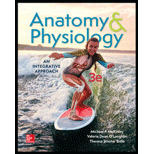
Anatomy and Physiology: An Integrative Approach with Connect Access Card
3rd Edition
ISBN: 9781260254440
Author: Michael McKinley, Valerie O'Loughlin, Theresa Bidle
Publisher: McGraw-Hill Education
expand_more
expand_more
format_list_bulleted
Textbook Question
Chapter 18, Problem 1CSL
While taking a clinical laboratory class, Marilyn prepared and examined blood smears from several donors. One of the smears had an increased percentage (about 10% of observed leukocytes) of cells containing reddish-orange granules. Discuss the type of cell described and the condition that may have caused this increase in the donor.
Expert Solution & Answer
Want to see the full answer?
Check out a sample textbook solution
Students have asked these similar questions
Generate one question that requires a Punnet Squre to solve the question. Then show how you calculate the possibilities of genotype and phenotype
Briefly state the physical meaning of the electrocapillary equation (Lippman equation).
Explain in a small summary how:
What genetic information can be obtained from a Punnet square? What genetic information cannot be determined from a Punnet square?
Why might a Punnet Square be beneficial to understanding genetics/inheritance?
Chapter 18 Solutions
Anatomy and Physiology: An Integrative Approach with Connect Access Card
Ch. 18.1 - Prob. 1LOCh. 18.1 - Prob. 1WDLCh. 18.1 - How does blood help regulate body temperature and...Ch. 18.1 - Prob. 2LOCh. 18.1 - Prob. 1WDTCh. 18.1 - Will blood be able to properly carry out its...Ch. 18.1 - Prob. 3LOCh. 18.1 - Prob. 4LOCh. 18.1 - Prob. 5LOCh. 18.1 - Prob. 4WDL
Ch. 18.1 - Prob. 5WDLCh. 18.2 - Prob. 6LOCh. 18.2 - Prob. 7LOCh. 18.2 - Prob. 6WDLCh. 18.2 - Prob. 7WDLCh. 18.2 - Prob. 8LOCh. 18.2 - Prob. 8WDLCh. 18.3 - Prob. 9LOCh. 18.3 - Prob. 10LOCh. 18.3 - Prob. 11LOCh. 18.3 - Prob. 12LOCh. 18.3 - Describe the process of erythropoiesis, beginning...Ch. 18.3 - What are the two main types of precursor cells for...Ch. 18.3 - Prob. 13LOCh. 18.3 - Prob. 14LOCh. 18.3 - Prob. 15LOCh. 18.3 - Prob. 16LOCh. 18.3 - Prob. 2WDTCh. 18.3 - WHAT DO YOU THINK?
3 Why is an individual with...Ch. 18.3 - Prob. 11WDLCh. 18.3 - Prob. 12WDLCh. 18.3 - Prob. 13WDLCh. 18.3 - Prob. 17LOCh. 18.3 - LEARNING OBJECTIVE
18. Distinguish between...Ch. 18.3 - Prob. 19LOCh. 18.3 - Prob. 14WDLCh. 18.3 - Prob. 15WDLCh. 18.3 - Prob. 20LOCh. 18.3 - Prob. 16WDLCh. 18.4 - Prob. 21LOCh. 18.4 - Prob. 22LOCh. 18.4 - Prob. 17WDLCh. 18.4 - Prob. 23LOCh. 18.4 - Prob. 4WDTCh. 18.4 - Prob. 18WDLCh. 18.4 - Prob. 19WDLCh. 18.4 - Prob. 24LOCh. 18.4 - Prob. 25LOCh. 18.4 - Prob. 26LOCh. 18.4 - Prob. 20WDLCh. 18.4 - At what point in blood loss is the sympathetic...Ch. 18.4 - Prob. 27LOCh. 18.4 - Prob. 5WDTCh. 18.4 - Prob. 22WDLCh. 18.5 - Prob. 28LOCh. 18.5 - Prob. 29LOCh. 18.5 - Prob. 23WDLCh. 18.5 - Prob. 24WDLCh. 18 - Prob. 1DYBCh. 18 - _____ 2. Which type of leukocyte increases during...Ch. 18 - Prob. 3DYBCh. 18 - Prob. 4DYBCh. 18 - Prob. 5DYBCh. 18 - Prob. 6DYBCh. 18 - Prob. 7DYBCh. 18 - _____ 8. During the recycling of components...Ch. 18 - _____ 9. The extrinsic pathway of coagulation is...Ch. 18 - _____ 10. A clot is best described as a. an...Ch. 18 - How does blood help regulate body temperature?Ch. 18 - What are alpha- and beta-globulins? What do they...Ch. 18 - When blood is centrifuged, a thin, whitish-gray...Ch. 18 - What is the shape of an erythrocyte, and why is...Ch. 18 - How are respiratory gases (oxygen and carbon...Ch. 18 - What are the anatomic characteristics of each type...Ch. 18 - How do the functions of basophils differ from...Ch. 18 - Briefly describe the origin, structure, and...Ch. 18 - Prob. 19DYBCh. 18 - Describe the three phases of hemostasis, and list...Ch. 18 - Use the following paragraph to answer questions...Ch. 18 - Prob. 2CALCh. 18 - Which sequence or pathway best describes the...Ch. 18 - Prob. 4CALCh. 18 - Prob. 5CALCh. 18 - While taking a clinical laboratory class, Marilyn...Ch. 18 - Abby is a nurse on duty in a hospital emergency...Ch. 18 - Prob. 3CSL
Knowledge Booster
Learn more about
Need a deep-dive on the concept behind this application? Look no further. Learn more about this topic, biology and related others by exploring similar questions and additional content below.Similar questions
- In a small summary write down:arrow_forwardNot part of a graded assignment, from a past midtermarrow_forwardNoggin mutation: The mouse, one of the phenotypic consequences of Noggin mutationis mispatterning of the spinal cord, in the posterior region of the mouse embryo, suchthat in the hindlimb region the more ventral fates are lost, and the dorsal Pax3 domain isexpanded. (this experiment is not in the lectures).a. Hypothesis for why: What would be your hypothesis for why the ventral fatesare lost and dorsal fates expanded? Include in your answer the words notochord,BMP, SHH and either (or both of) surface ectoderm or lateral plate mesodermarrow_forward
arrow_back_ios
SEE MORE QUESTIONS
arrow_forward_ios
Recommended textbooks for you
 Medical Terminology for Health Professions, Spira...Health & NutritionISBN:9781305634350Author:Ann Ehrlich, Carol L. Schroeder, Laura Ehrlich, Katrina A. SchroederPublisher:Cengage Learning
Medical Terminology for Health Professions, Spira...Health & NutritionISBN:9781305634350Author:Ann Ehrlich, Carol L. Schroeder, Laura Ehrlich, Katrina A. SchroederPublisher:Cengage Learning- Case Studies In Health Information ManagementBiologyISBN:9781337676908Author:SCHNERINGPublisher:Cengage

Medical Terminology for Health Professions, Spira...
Health & Nutrition
ISBN:9781305634350
Author:Ann Ehrlich, Carol L. Schroeder, Laura Ehrlich, Katrina A. Schroeder
Publisher:Cengage Learning



Case Studies In Health Information Management
Biology
ISBN:9781337676908
Author:SCHNERING
Publisher:Cengage


Complications during Labour and Delivery; Author: FirstCry Parenting;https://www.youtube.com/watch?v=QnCviG4GpYg;License: Standard YouTube License, CC-BY